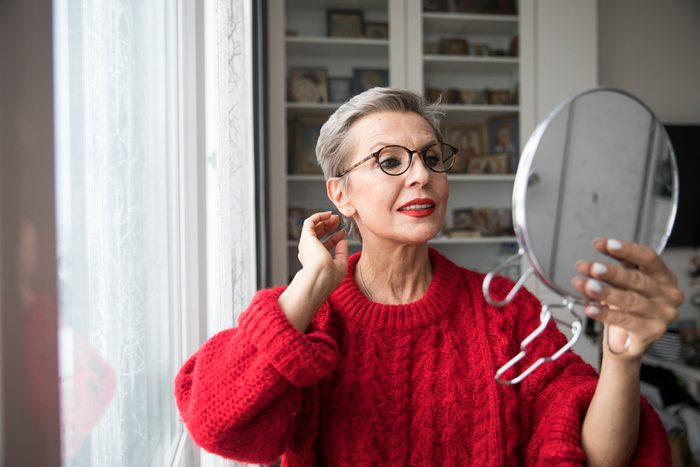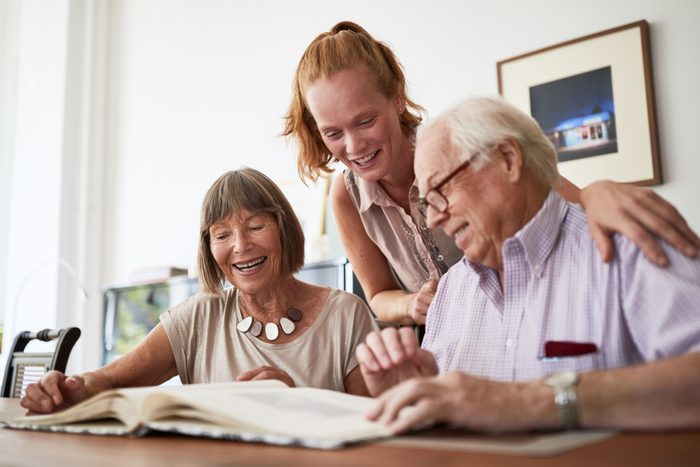
What causes gray hair?
Although silver-gray hair is a trendy hair dye color, many people don’t go gray by choice. And there are different factors that contribute to the process of premature graying. Technically, premature graying is defined as going gray before age 20 if you are white, or before age 30 if you are Black, but getting gray hair in your 20s, 30s, or 40s can feel like too soon.
In general, gray hairs happen when melanin (natural pigment or color) stops forming. In general, 74 percent of people aged 45 to 65 will have gray hair with an intensity of about 27 percent, according to a 2012 survey in the British Journal of Dermatology. However, there is a lot of variability. Why does that happen? Here are the reasons why your hair might be turning gray sooner than you’d like.

Your mom (or dad) grayed early
You’ve probably always wondered what causes gray hair? Well, steel-colored locks are partly in your genes, says Doris Day, MD, clinical associate professor of dermatology at New York University Langone Medical Center and author of Forget the Facelift. A 2016 study published in Nature Communications isolated one gene variant linked to graying after researchers analyzed hair features of 6,000 Latin Americans. Though you might be surprised about just how much gray you have if you’ve been coloring your hair for years (or decades), says Dr. Day. And you can blame mom and dad. Just like whether you go bald or not, graying genes come from both sides of the family, says Dr. Day. (Gray hair is a natural part of aging, but dermatologists want you to stop believing these anti-aging myths.)

You may have an autoimmune condition
The autoimmune skin disease called alopecia areata can lead to bright white strands. As the National Alopecia Areata Foundation (NAAF) explains, people with the condition develop small, round, smooth patches on the scalp, and they can completely lose hair on their head or body.
“This happens because your immune system attacks your hair follicles, making your hair fall out. When it grows back, it grows back white,” explains Dr. Day. Some 6.8 million people in America have or will develop the condition, according to the NAAF. If you notice worrisome hair loss or a bald patch, talk to your dermatologist.

Your environment is polluted
Pollutants and toxins can cause you to gray faster, according to the Library of Congress. These chemicals generate free radicals—or oxidative stress—that damage melanin production and speed hair aging. But once hair grows out of the follicle, it’s dead, adds Dr. Day. “It’s really about what gets to the follicle level that will make the most marked difference. While these environmental issues may have an impact, other reasons, like stress, matter more,” she says. (More on that in a minute.) (Here are more things your hair can reveal about your health.)

You’re super stressed
When President Obama entered office his hair was dark. Five years later, people were concerned: He completely transformed to silver. The link between stress and gray hair is hotly debated. However, says Dr. Day, “stress will accelerate your genetic destiny.”
Meaning, if you’re not going to go gray any time soon, stress is unlikely to change your hair color. But if going gray is in your genes, stress can make your hair turn gray faster and earlier—unless you make an effort to manage stress. (Plus, stressing out about every little thing is just one of the many habits that can make you age faster.)

You’re exposed to cigarette smoke
If you’re still asking yourself, “What causes gray hair?”, you may want to blame the cigarettes in your house. Whether it’s you or someone else doing the puffing, exposure to cigarette smoke can affect your hair color. Research published in the Indian Dermatology Online Journal found that smokers have 2.5 times greater odds of early graying, likely because of the huge amounts of free radicals generated by lighting up. (Count this as one more reason to quit—or encourage a loved one to break the habit.)

Your hormones are changing
One glance at a photo of you a decade ago can tell you this, but your hair is not the same now as it was then. So, what causes gray hair to start? Thanks to hormones, your hair can change over time in texture, density, and, yes, color. “This process starts to be most noticeable when you turn 30. “That’s the age when people start to come in and complain about these issues,” says Dr. Day. Experts are still trying to understand precisely how hormones (like estrogen, progesterone, and cortisol) influence graying, she says. And certainly, there are women in their 50s going through menopause who have not a strand of gray hair. It may be a trifecta of events coming to a head: your genetics, environmental factors, and hormonal changes.

It’s your age
You may not be ready for the gray, but your hair is. Melanin production—what gives hair its pigment—decreases with age. For every decade after you turn 30, your risk of going gray increases 10 to 20 percent, according to the Library of Congress. So while some people may be able to maintain their natural hair color for longer, it’s inevitable. “In time, everyone’s hair goes gray,” according to the site. (Aside from graying early, here are 15 more signs your body is aging faster than you are.)

